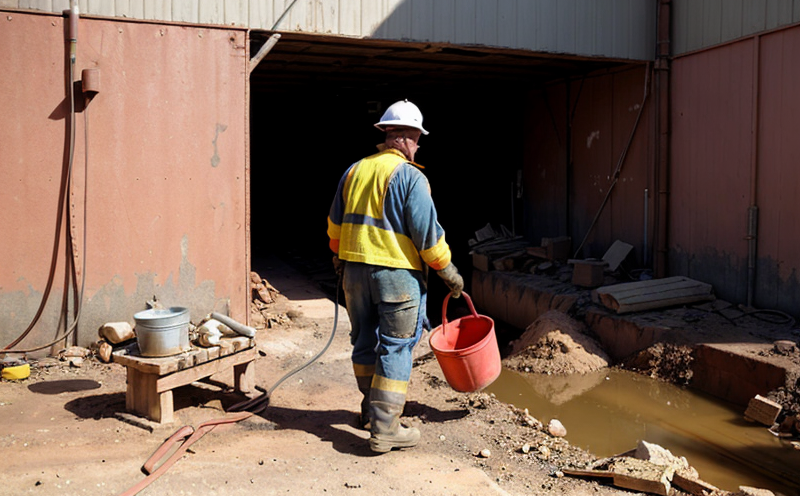EN 166 Personal Eye Protection Testing in Mines
The European Standard EN 166 specifies requirements and tests for personal eye protection equipment used to safeguard the eyes against various risks such as mechanical impact, chemical splashes, and other potential hazards. In mining environments where the risk of injury is high due to dust, debris, and other materials, this standard ensures that protective eyewear meets rigorous safety standards.
The testing process under EN 166 aims to verify the durability, comfort, and overall effectiveness of eye protection devices in a range of adverse conditions. This includes assessing the ability of the glasses or goggles to withstand impact from flying particles, penetration by corrosive substances, and other hazards common within mining operations.
The tests are designed to ensure that the eyewear can be relied upon during critical moments when workers may not have time for a second thought about their safety. Compliance with EN 166 is essential for maintaining a safe working environment in mines where even minor lapses could lead to severe injuries or accidents.
The testing process involves several stages, including impact resistance tests, chemical splash resistance tests, and field durability assessments. Impact resistance tests involve simulating real-world scenarios of flying particles striking the eyewear at high speeds. Chemical splash resistance tests assess how effectively the eyewear can prevent corrosive substances from reaching the eyes.
Field durability assessments are critical for ensuring that the equipment maintains its protective properties over extended periods and under varying environmental conditions. These assessments include evaluating factors such as fogging, condensation, and overall comfort during prolonged use in harsh environments.
The testing process also includes a series of fit checks to ensure that the eyewear fits comfortably and securely on the wearer's face, which is crucial for maximum protection. This involves measuring the size, shape, and compatibility of the glasses or goggles with different head shapes and facial structures.
Once the tests are completed, detailed reports are generated providing a comprehensive overview of each piece of protective eyewear’s performance against specified criteria. These reports serve as critical documentation for compliance purposes, helping mine operators ensure that they meet all relevant safety regulations and standards.
The use of EN 166 compliant eye protection in mines is not just a regulatory requirement but also a best practice for maintaining a safe working environment. By adhering to these stringent testing protocols, mining companies can significantly reduce the risk of eye injuries among their workforce, leading to increased productivity and reduced healthcare costs.
The standard's emphasis on durability and comfort makes it particularly suitable for use in mines where workers may be exposed to multiple hazards over extended periods. The rigorous testing ensures that miners can rely on their protective eyewear, knowing that it has been rigorously evaluated under conditions similar to those they will encounter in the field.
Moreover, compliance with EN 166 is a key factor in maintaining a positive safety culture within mining operations. By ensuring that all workers are equipped with high-quality eye protection, companies demonstrate their commitment to worker safety and well-being, which can lead to higher morale and better job satisfaction among employees.
The testing process for EN 166 personal eye protection is designed to be robust, comprehensive, and reflective of the real-world conditions miners face. This ensures that the eyewear not only meets regulatory requirements but also provides effective protection in challenging environments. The detailed reports generated from these tests serve as a valuable resource for quality managers, compliance officers, R&D engineers, and procurement teams, helping them make informed decisions regarding safety equipment.
Industry Applications
- Mining operations where workers are exposed to mechanical impact hazards.
- Civil engineering sites with potential for chemical splashes or flying debris.
- Tunneling and excavation projects in hazardous environments.
- Construction sites requiring eye protection against dust and other airborne particles.
Eurolab Advantages
Eurolab, with its extensive experience in laboratory testing and validation services, offers unparalleled expertise in EN 166 compliance for personal eye protection equipment. Our state-of-the-art facilities are equipped with the latest instrumentation to conduct thorough impact resistance tests, chemical splash resistance tests, and field durability assessments.
Our team of experienced professionals ensures that each piece of protective eyewear is rigorously evaluated against specified criteria, providing detailed reports that serve as a critical resource for quality managers, compliance officers, R&D engineers, and procurement teams. Eurolab's commitment to accuracy and reliability guarantees that our clients can trust the results we provide.
We pride ourselves on offering personalized service tailored to each client’s specific needs. Our extensive network of industry contacts allows us to stay abreast of the latest developments in safety standards and regulations, ensuring that our testing protocols remain up-to-date and relevant.
International Acceptance and Recognition
The European Standard EN 166 is widely recognized and accepted across Europe and beyond. Compliance with this standard ensures that personal eye protection equipment meets the highest safety standards, which is crucial for maintaining a safe working environment in various industries.
Many countries outside of Europe have also adopted or are considering adopting similar standards to ensure worker safety. The international acceptance of EN 166 reflects its reputation as a leading benchmark for personal eye protection equipment testing and validation.
The standard's rigorous testing protocols and detailed reporting make it an attractive choice for manufacturers looking to export their products to multiple markets. By ensuring compliance with EN 166, companies can gain a competitive edge in the global market while maintaining high standards of safety and quality.





